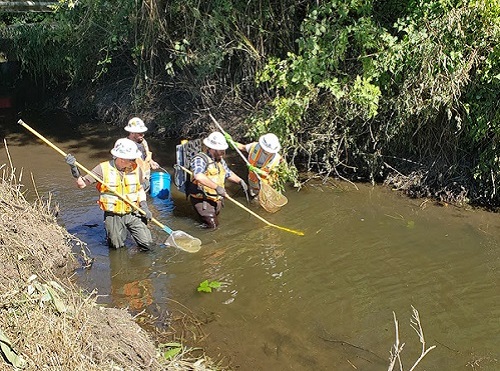Construction crews with the Washington State Department of Transportation are often called upon to execute unusual tasks within their road building and maintenance activities – and that can include “going fishing” as part of stream realignment efforts.
[Above photo by WSDOT]
The agency noted in a recent blog post that a good portion of its transportation infrastructure work involves streams and wetlands, especially in the Pacific Northwest, where roads, streams, and wetlands often intersect.
For example, WSDOT pointed to the SR 167 Completion Project in Pierce County – located in an area where I-5 crosses over Hylebos Creek at the Fife curve, with tributaries and wetlands on either side of the freeway. As a result, WSDOT construction crews made changes so the freeway, creek, and wetlands can co-exist in harmony – work that included a wetland and stream restoration project, revitalizing almost 150 acres of land on either side of I-5 near the Fife curve.
[Editor’s note: The Federal Highway Administration recently issued $196 million to 59 tribal, state, and local governments to help fix or remove 169 culvert barriers to improve fish passage. The agency said outdated culverts and other related infrastructure can cause roads to flood and severely restrict or altogether block fish passage.]
As part of that restoration effort, in mid-July, WSDOT crews removed fish from Hylebos Creek so they could rebuild and realign a 2,200-foot section of the stream by mid-September. Crews carefully removed fish from the stream’s work zone and relocated them another area of the creek where they won’t be affected by construction work – a process technically known as “de-fishing,” the agency explained.
WSDOT noted its crews are only allowed to step foot or put equipment into a stream during a designated “fish window,” which is often mid-summer to early fall, depending on the stream, when the fewest number of fish are generally present.
The agency stressed that its crews are not “fishing” in the traditional sense when conducting such “de-fishing” operations. They set up and secure fine-meshed netting, dragging it in the water to encourage fish to naturally swim downstream away from the construction area – basically “shooing” them out of the area – as it is less stressful for the fish if they can swim away on their own. The crews will then secure another fine-meshed net in the stream to block off the area they just waded through so the fish do not return to the just-cleared area.
WSDOT noted that any fish stragglers trapped between the two secured nets are removed first by “seining passes” followed by “electro-fishing,” whereby a very small electrical charge in the water temporarily stuns the remaining fish so they can be gently scooped up in nets by trained fish handlers. WSDOT noted that crews keep moving downstream, repeating this entire process, until all the fish are caught and relocated safely from the construction area.
